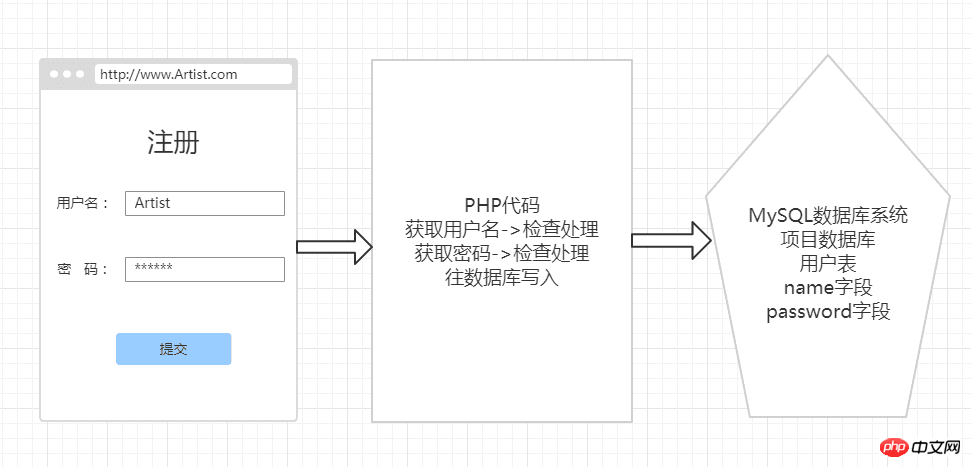Home >Backend Development >PHP Tutorial >PHP login registration BootStrap form implementation function
PHP login registration BootStrap form implementation function
- PHPzOriginal
- 2018-05-26 15:40:542824browse
Login and registration are the most common modules we use in web development, and they are also functions we often come into contact with in our daily lives. Through this article, I will share with you the BootStrap form function of login registration in PHP. Friends who need it can refer to it
Related recommendations: "Bootstrap Tutorial"
Preface
The previous articles briefly introduced some knowledge points about the front-end and PHP. Form submission in the front-end is a very important module. In this article I will introduce some knowledge about forms. If you have not mastered the previous content well and have not practiced a lot, I think you'd better write down all the labels first.

Project Introduction
Login and registration are the most common modules we use in web development, and they are also Functions that we often come into contact with in our daily lives. The user fills in the content through the front-end form page and submits it to the backend through POST. Then, after the submitted content is processed by the PHP code, the login or registration logic continues.
Login and registration diagram


<html> <head> <meta charset="UTF-8"> <title>Register</title> </head> <body> </body> </html>Then we click Start to find the following content

<html> <head> <meta charset="UTF-8"> <title>Register</title> <!-- 最新版本的 Bootstrap 核心 CSS 文件 --> <link rel="stylesheet" href="https://cdn.bootcss.com/bootstrap/3.3.7/css/bootstrap.min.css" integrity="sha384-BVYiiSIFeK1dGmJRAkycuHAHRg32OmUcww7on3RYdg4Va+PmSTsz/K68vbdEjh4u" crossorigin="anonymous"> </head> <body> </body> </html>BootStrap gives many cases, including a login page case http://v3.bootcss.com/examples/signin/Let’s imitate this page
<html>
<head>
<meta charset="UTF-8">
<title>Register</title>
<!-- 最新版本的 Bootstrap 核心 CSS 文件 -->
<link rel="stylesheet" href="https://cdn.bootcss.com/bootstrap/3.3.7/css/bootstrap.min.css" integrity="sha384-BVYiiSIFeK1dGmJRAkycuHAHRg32OmUcww7on3RYdg4Va+PmSTsz/K68vbdEjh4u" crossorigin="anonymous">
<style>
body {
padding-top: 40px;
padding-bottom: 40px;
background-color: #eee;
}
.form-signin {
max-width: 330px;
padding: 15px;
margin: 0 auto;
}
</style>
</head>
<body>
<p class="container">
<form class="form-signin" action="" method="post">
<h2 class="form-signin-heading">Please sign in</h2>
<label for="inputEmail" class="sr-only">Email address</label>
<br>
<input type="email" name="email" id="inputEmail" class="form-control" placeholder="Email address" required autofocus>
<br>
<label for="inputPassword" class="sr-only">Password</label>
<input type="password" name="password" id="inputPassword" class="form-control" placeholder="Password" required>
<br>
<input type="submit" class="btn btn-lg btn-primary btn-block" type="submit" value="Sign in">
</form>
</p>
</body>
</html>
 ##c9ccee2e6ea535a969eb3f532ad9fe89531ac245ce3e4fe3d50054a55f265927 is wrapped in CSS. If you have any doubts, you can look at Baidu one by one, or you can not write CSS first, and then Add CSS code bit by bit to see the effect. Let's analyze the form in HTML.
##c9ccee2e6ea535a969eb3f532ad9fe89531ac245ce3e4fe3d50054a55f265927 is wrapped in CSS. If you have any doubts, you can look at Baidu one by one, or you can not write CSS first, and then Add CSS code bit by bit to see the effect. Let's analyze the form in HTML.
•The form tag ==> is used to wrap the form content and is also the starting tag of the form.
•The attribute action==>action="xxx" of the form tag fills in the file address where the PHP code for processing the form is located. After clicking the submit button, the form will send the data to this address.
•The attribute method==> of the form tag is a bit difficult to understand. Just remember to fill in post when submitting the form, method="post". If you are interested, you can check it on Baidu.
•input tag ==> Careful friends can see that input exists alone. The d5fd7aea971a85678ba271703566ebfd tag specifies the input field in which the user can enter data. The d5fd7aea971a85678ba271703566ebfd element is used within the ff9c23ada1bcecdd1a0fb5d5a0f18437 element to declare an input control that allows users to enter data.
Input fields can be changed in a variety of ways, depending on the type attribute. Common type attributes include text, email, password, checkbox, radio, button, submit, hidden, etc. You can try changing the type to see the effect.
•The attribute name of the input tag==>This name value is crucial. The reason why our background PHP code can tell which input box each value comes from is based on name="xx "To judge.
•Input tag attribute required==>If the user writes nothing, can we allow them to submit the form? Obviously not, so we need to let the user fill in the content before submitting. required means necessary. If you click submit without filling in the content, the form will not be submitted.
Summarize
The above is the detailed content of PHP login registration BootStrap form implementation function. For more information, please follow other related articles on the PHP Chinese website!

